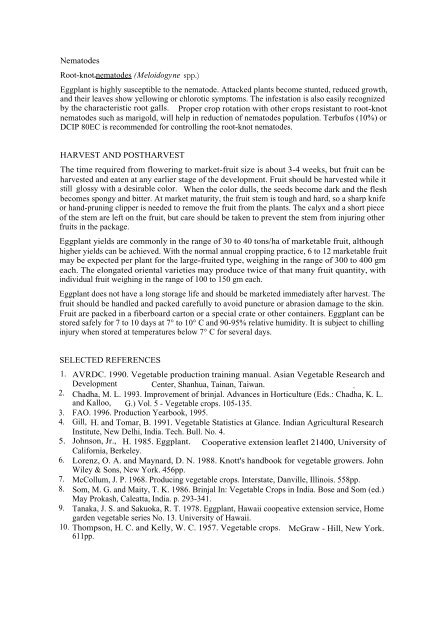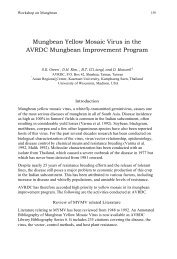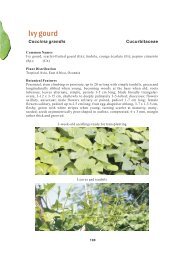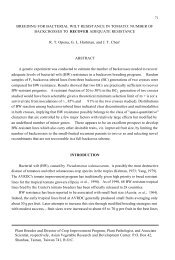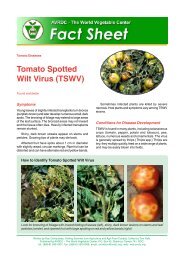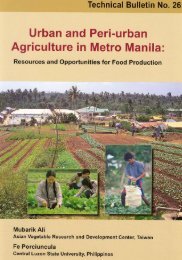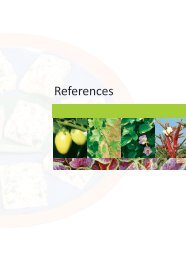CULTIVATION AND SEED PRODUCTION OF EGGPLANT NC Chen
CULTIVATION AND SEED PRODUCTION OF EGGPLANT NC Chen
CULTIVATION AND SEED PRODUCTION OF EGGPLANT NC Chen
You also want an ePaper? Increase the reach of your titles
YUMPU automatically turns print PDFs into web optimized ePapers that Google loves.
Nematodes<br />
Root-knot nematodes (Meloidogyne spp.)<br />
Eggplant is highly susceptible to the nematode. Attacked plants become stunted, reduced growth,<br />
and their leaves show yellowing or chlorotic symptoms. The infestation is also easily recognized<br />
by the characteristic root galls. Proper crop rotation with other crops resistant to root-knot<br />
nematodes such as marigold, will help in reduction of nematodes population. Terbufos (10%) or<br />
DCIP 80EC is recommended for controlling the root-knot nematodes.<br />
HARVEST <strong>AND</strong> POSTHARVEST<br />
The time required from flowering to market-fruit size is about 3-4 weeks, but fruit can be<br />
harvested and eaten at any earlier stage of the development. Fruit should be harvested while it<br />
still glossy with a desirable color. When the color dulls, the seeds become dark and the flesh<br />
becomes spongy and bitter. At market maturity, the fruit stem is tough and hard, so a sharp knife<br />
or hand-pruning clipper is needed to remove the fruit from the plants. The calyx and a short piece<br />
of the stem are left on the fruit, but care should be taken to prevent the stem from injuring other<br />
fruits in the package.<br />
Eggplant yields are commonly in the range of 30 to 40 tons/ha of marketable fruit, although<br />
higher yields can be achieved. With the normal annual cropping practice, 6 to 12 marketable fruit<br />
may be expected per plant for the large-fruited type, weighing in the range of 300 to 400 gm<br />
each. The elongated oriental varieties may produce twice of that many fruit quantity, with<br />
individual fruit weighing in the range of 100 to 150 gm each.<br />
Eggplant does not have a long storage life and should be marketed immediately after harvest. The<br />
fruit should be handled and packed carefully to avoid puncture or abrasion damage to the skin.<br />
Fruit are packed in a fiberboard carton or a special crate or other containers. Eggplant can be<br />
stored safely for 7 to 10 days at 7° to 10° C and 90-95% relative humidity. It is subject to chilling<br />
injury when stored at temperatures below 7° C for several days.<br />
SELECTED REFERE<strong>NC</strong>ES<br />
1. AVRDC. 1990. Vegetable production training manual. Asian Vegetable Research and<br />
Development Center, Shanhua, Tainan, Taiwan. _<br />
2. Chadha, M. L. 1993. Improvement of brinjal. Advances in Horticulture (Eds.: Chadha, K. L.<br />
and Kalloo, G.) Vol. 5 - Vegetable crops. 105-135.<br />
3. FAO. 1996. Production Yearbook, 1995.<br />
4. Gill, H. and Tomar, B. 1991. Vegetable Statistics at Glance. Indian Agricultural Research<br />
Institute, New Delhi, India. Tech. Bull. No. 4.<br />
5. Johnson, Jr., H. 1985. Eggplant. Cooperative extension leaflet 21400, University of<br />
California, Berkeley.<br />
6. Lorenz, O. A. and Maynard, D. N. 1988. Knott's handbook for vegetable growers. John<br />
Wiley & Sons, New York. 456pp.<br />
7. McCollum, J. P. 1968. Producing vegetable crops. Interstate, Danville, Illinois. 558pp.<br />
8. Som, M. G. and Maity, T. K. 1986. Brinjal In: Vegetable Crops in India. Bose and Som (ed.)<br />
May Prokash, Caleatta, India. p. 293-341.<br />
9. Tanaka, J. S. and Sakuoka, R. T. 1978. Eggplant, Hawaii coopeative extension service, Home<br />
garden vegetable series No. 13. University of Hawaii.<br />
10. Thompson, H. C. and Kelly, W. C. 1957. Vegetable crops. McGraw - Hill, New York.<br />
611pp.


